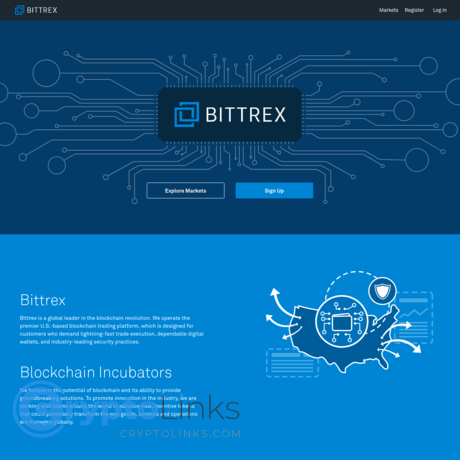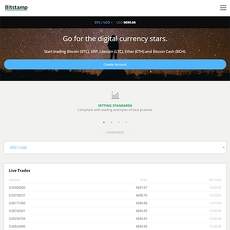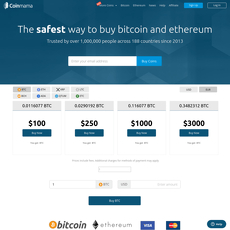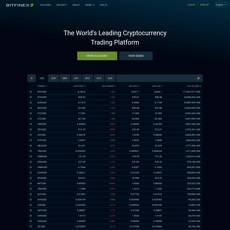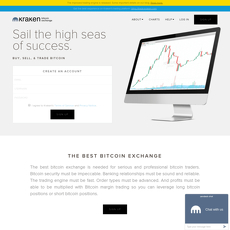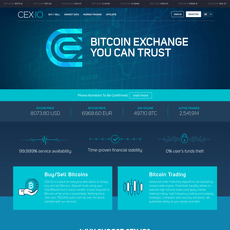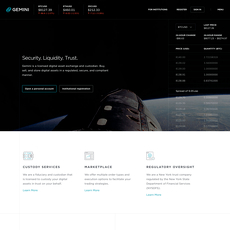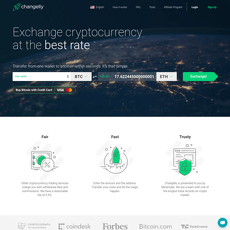Bittrex Review
Bittrex
bittrex.com
Bittrex Review Guide: Everything You Need to Know Before Trading Crypto
Ever sat at your computer, staring at a wall of crypto exchanges, wondering which one you can actually trust with your Bitcoin or altcoins? You’re definitely not the only one. The crypto world is a maze—one wrong move and things can get messy, quick. So, is Bittrex the answer to your trading worries… or just another name in the crowd?
The Struggles of Finding a Reliable Crypto Exchange
Let’s face it—trying to pick a good crypto exchange these days feels a lot like trying to pick a good avocado: most look great from the outside, but it’s what’s inside that matters! You’re bombarded with platforms that promise safety, low fees, and all the coins under the sun. But:
- Some sketchy sites can disappear with your funds overnight.
- Fees can be confusing — or just downright sneaky.
- The risk of hacks is real. According to a 2023 report by Chainalysis, over $3.8 billion was stolen from crypto platforms in just one year.
Whether you’re just starting to research how to buy your first Bitcoin (still holding the crown as the “king of crypto,” by the way), or want to expand your altcoin collection, the wrong exchange can burn you fast. Security, transparency, fees, and actual ease of use—it all matters.
I’m Here to Help You Make Sense of Bittrex
If you’ve landed here, you’re probably hoping for some honest answers about Bittrex:
- Is it safe?
- Are the signup steps actually straightforward, or is it a paperwork nightmare?
- Will you get slammed with hidden fees?
- And, most importantly—will you actually enjoy using it?
I’ll show you exactly how Bittrex stacks up—not just with flashy marketing, but how it feels in real-world use. Plus, I’ll walk you through what to expect when you cash out (yes, you can turn your crypto into actual money), tips for safe trading, and the things nobody tells you… until it’s too late.
Why Trust This Guide?
Every day, I put crypto exchanges under the microscope to save you from the headaches, traps, and letdowns. My goal: help you skip the scams, trade smarter, and actually enjoy the experience.
“If only someone had warned me about those withdrawal fees…” Sound familiar? Not on my watch.
If you’re serious about avoiding crypto disasters and want real answers about Bittrex, you’re in the right place.
Ready to find out what Bittrex really offers—and if it’s the right fit for you? Stick with me, because next up I’m breaking down exactly what Bittrex is, its backstory, and quick facts that every smart trader should know. Curious how it all began and what makes it different from the pack? Let’s pull back the curtain…
What is Bittrex? Overview & Quick Facts
The History and Reputation of Bittrex
If you’ve been poking around the crypto sphere for a while, you’ve probably heard Bittrex's name come up—usually in conversations about safety and reliability. Founded back in 2014 by three cybersecurity engineers (yep, real security pros from Microsoft, Amazon, and BlackBerry), Bittrex quickly built its reputation as a rock-solid, security-focused exchange. While hundreds of exchanges have come and gone, Bittrex has stood strong—even in tough times when other platforms struggled or bailed on their users.
Bittrex operates as a centralized exchange—meaning you’re trusting their infrastructure, not some mystery code. I know a lot of people worry about trusting a central platform, and while no exchange is bulletproof, Bittrex has never suffered a catastrophic hack that wiped out customer funds. That’s a pretty big deal in a world where security slip-ups have tanked entire exchanges.
"The only thing more volatile than the price of Bitcoin is the fate of an insecure exchange. Picking the right platform can literally save your bankroll."
Its steady presence in the US and for much of the globe adds to its reputation, even as regulatory climates keep changing. People often describe Bittrex as “boring—but in a good way,” because it’s designed to be dependable, not flashy or risky.
Core Features at a Glance
Let’s get straight to what you can actually do with Bittrex. This is not some narrow, coin-only platform where you constantly hit “Asset Not Supported” errors. Here’s what stands out:
- Buy, sell, and trade a very broad range of cryptocurrencies—Bitcoin, Ethereum, USDT, XRP, DOGE, and hundreds of altcoins you might not spot elsewhere.
- Fiat pairs available—connect your USD, EUR, or other fiat account right to crypto markets (though be aware: not every country or state is supported for fiat access—double-check before you’re ready to cash out).
- Advanced and basic trading tools—plan a simple market buy, or get into limit orders/charts if you’re feeling technical.
- Global reach—Bittrex serves users in dozens of countries, but if you’re in “restricted” areas (say, some US states or sanctioned nations), you’ll need an alternative. Always check their official FAQ for the latest list.
- Speedy order matching—the backend is built for fast trades, which helps during those wild crypto moments when prices jump or dive in seconds.
Bittrex is kind of the exchange I point people to when they want the stability and straightforwardness of Coinbase, but way more trading pairs and more privacy-conscious policies—more on that in the next part.
Who is Bittrex Best For?
One of my favorite things about Bittrex: it strikes a solid middle ground. Beginners won’t be lost in endless technical jargon, and seasoned traders won’t find it “dumbed down” or missing serious features.
- Beginners: Getting started is pretty painless. The interface is clean, not loaded with flashing lights or cryptic charts. There’s a helpful learning curve, not a brutal one.
- Serious traders: Depth of market, limit/stop orders, hundreds of assets, and juicy liquidity make Bittrex a comfortable “home base” even if you’ve traded on Binance or Kraken.
- Privacy-minded users: If you care about compliance but still want strong privacy, Bittrex’s KYC is robust but not invasive for smaller-volume users—and it’s run by ex-security engineers, so they get the value of keeping user info safe.
That said—not every cryptocurrency exchange is meant for everyone. If you want pure peer-to-peer trading, Bittrex is not the answer. But if you need a trustworthy, well-regulated platform that won’t randomly vanish (like QuadrigaCX or FTX), it’s a strong contender.
So, thinking about jumping in? Wondering how the sign-up and verification actually work—and whether the process is as smooth as it sounds? In the next section, I’ll walk you step-by-step through creating your account on Bittrex (and share a couple of personal tips I’ve learned from seeing real people trip up during registration). Curious what’s required? Wait until you see which everyday documents unlock your first trades…
Getting Started: Creating an Account and KYC
How to Sign Up
Opening a Bittrex account is usually smoother than most people expect—but it’s important to know what you’re signing up for before you start. Picture this: you’re excited to get your hands on some crypto, but you hit a wall at the first hurdle because you didn't have a document handy. Save yourself some time (and stress) by prepping what you need upfront.
- Email address (make sure it’s secure and unique)
- A strong, unforgettable password
- Government-issued ID (like a passport or driver’s license) for identity verification
- Your smartphone (you’ll need it more than once!)
Registration follows a familiar script: visit the official Bittrex website, tap ‘Sign Up,’ fill in your details, and agree to the terms. Don’t be surprised when they ask for a selfie—this is now a standard step in the game.
Quick tip from my own experience: If your ID is expired, you’re out of luck! The system’s automated checks will just keep looping you back. Make sure your documents are current, readable, and uploaded in full color—Bittrex's system is a stickler for detail.
KYC, AML, and Rule Compliance
Let’s get real: most of us want crypto for privacy, but compliance is unavoidable. Bittrex is serious about Know Your Customer (KYC) and Anti-Money Laundering (AML) rules. That means no skipping ID checks.
“Privacy is not an option, and it shouldn’t be the price we accept for just getting on an exchange.”
It can feel intrusive, but this is what keeps the site above-board and shields you from nasty surprises like frozen funds or legal headaches. On Bittrex, everyone—including US users—goes through:
- Photo ID verification
- Personal details cross-checking (sometimes including proof of address)
- You may even get asked for a selfie with your ID during random compliance reviews
In my experience, Bittrex leans toward being strict, but the platform is reasonably quick—most verifications are done within 15 minutes to a couple of hours. But, as with any centralized exchange, don’t expect privacy in the old-school crypto sense.
You’re also locked out from signing up if you’re from a restricted country. That’s not personal—just legal stuff that Bittrex strictly enforces behind the scenes. (Curious if your region makes the cut? Heads up: the support team answers fast, but always check the eligibility list first.)
Safety Tip: Avoiding Scams During Signup
I’ve seen it too many times—someone starts signing up for an exchange, and boom, accidentally ends up on a phishing site that steals their data or funds. That’s just the reality of crypto in 2024, where scammers are lurking everywhere. Here’s how to protect yourself from day one:
- Bookmark the official Bittrex site: Enter the URL yourself, don’t trust random search results or ads.
- Never share login info: Legit exchanges will never DM you asking for your password or codes.
- Check for HTTPS: The site must show a padlock in the browser bar—anything else is a red flag.
- Don’t download unofficial apps: Only use links to the Bittrex app from the official website.
Want one chilling stat? According to a 2023 study by Chainalysis, over $1 billion was lost in phishing attacks targeting crypto users last year. Most of those losses started the very first day—during sign-up!
So, eyes wide open and never let your guard down. Getting your account set up right is the first win in your crypto journey.
Ever wondered if all this is worth it, especially after jumping through so many hoops just to get verified? What’s Bittrex really like once you’re inside? You’ll want to stick around—next up, I’ll spill the real deal on Bittrex’s trading experience, from what the app feels like to how fast your orders actually move. Ready for the inside scoop?
Bittrex Trading Experience: How Easy is it Really?
User Interface and Mobile Friendliness
Ever opened a trading platform and felt utterly lost, like you’re looking at a spaceship control panel? Bittrex surprised me, honestly. Their interface is crisp. Everything important stands out, and I don’t have to hunt for basic actions like depositing, buying, or checking balances. It’s not just “pretty”—it’s practical.
On desktop, the navigation sidebar keeps features in reach, while on mobile, the app retains nearly all the same functions. No tiny, squint-at-your-screen buttons or bizarre menu layouts here.
I remember trying to sell some altcoins while on the go, waiting for coffee. With the Bittrex app, it was smooth: logged in, swapped my tokens, and checked confirmations—all before my name was called. That clean UX matters more than most people realize. One study from Nielsen Norman shows that intuitive interfaces increase trust and keep users trading longer. Confusion, on the other hand, leads to mistakes—and those can be expensive in crypto.
“Great design isn’t just about looks, it’s about making your day easier—especially when real money’s on the line.”
Supported Coins, Tokens, and Markets
Want variety? Bittrex supports hundreds of cryptocurrencies. Of course, Bitcoin is everywhere (wouldn’t be a crypto exchange without it), but you’ll also spot loads of familiar altcoins like Ethereum, Cardano, Solana—and quite a few hidden gems, too.
- Bitcoin (BTC), Ethereum (ETH), Tether (USDT): All the big names covered.
- Wide Range of Alts: From Polkadot to Monero, to tokens most folks haven’t even heard of yet.
- Crypto-to-crypto pairs: Swap between coins without touching fiat if you want.
- Crypto-to-fiat: BTC/USD, ETH/USD, and select others for those who need to cash out or get in with dollars or euros.
Keep in mind, availability depends on your country. Still, if you ever got frustrated because your favorite project wasn’t listed elsewhere, odds are it’s on Bittrex—just use the search and see for yourself.
Deposit & Withdrawal Options
Getting your money in (or out) shouldn’t be a stress test. Bittrex handles both crypto and fiat, but there are a few things you’ll want to note before moving funds around:
- Crypto deposits: Just select your coin, copy the address (always double-check!), and send. Most arrivals are credited after a basic number of blockchain confirmations.
- Fiat deposits: Available for verified users, usually via wire transfer or bank transfer (ACH for USA). No credit cards for fiat at the time of writing.
- Withdrawals: Withdraw to any personal wallet, or send fiat back to your bank once you’ve linked it. Speed varies: most crypto withdrawals are near-instant after processing, but fiat sometimes takes 1–3 business days to hit your account.
- Minimums & fees: There’s a minimum withdrawal for both crypto and fiat, and sometimes you’ll pay a small network or service fee. Watch for these—they can take a bite out of small transactions.
Pro tip: Always double-check deposit addresses (copy-paste, don’t type) and keep an eye on notifications for status updates. If an amount seems missing, support is usually quick to trace it.
How Fast are the Trades on Bittrex?
Speed equals opportunity in crypto. A slow trade, and the price can slip right through your fingers. I’ve tested a lot of exchanges—some hang or lag, especially during market surges. Bittrex has rarely made me wait. Their matching engine is seriously robust, and I’ve seen market and limit orders execute in literally seconds.
Liquidity also makes a difference. Bittrex is no Binance or Coinbase in “mainstream volume,” but there’s usually enough action on top coins for fast fills without wild price swings. Some thinly traded tokens might take longer, but that’s true across the industry.
One reason I keep coming back to Bittrex for testing? I know that, if I place a BTC order, it’s either filled right away or just sits in the order book waiting—it’s transparent, and there’s no hidden “processing” stage.
Do you care how much a slow or fast order actually costs? In the next section, I'll unpack something most traders overlook: the exact fee structure—where Bittrex wins, where it stings, and all the fine print that matters if you’re hoping to maximize profits (or avoid disappointments). Still wondering if Bittrex really pays off? Let’s follow the money together.
Trading Costs: Fees Explained
Deposit, Withdrawal, and Trading Fees
Let’s cut through the numbers: Fees can make or break your crypto trading journey, whether you’re flipping Bitcoin or hunting for the next altcoin gem. On Bittrex, the fee system is pretty transparent compared to some competitors, but it pays (literally) to know what you’ll be charged.
Trading fees on Bittrex use a maker/taker model. As of my latest research, regular users pay 0.35% per trade—a flat fee, no matter if you’re buying or selling. The more you trade in a 30-day window, the better it gets. If you’re in whale territory and push over $100,000 in trades in a month, your fee can shrink to 0.20% (and even lower for ultra-high rollers).
Deposits are usually free for both crypto and fiat methods–you won’t see Bittrex charging for sending in funds. Withdrawals, though, are a different story. For crypto, you’ll pay a network fee (that goes to miners, not Bittrex themselves), and each coin has its own charge. For example, withdrawing Bitcoin will often run you around 0.0005 BTC.
For USD withdrawals, wire transfer fees usually sit at about $25 per transaction, while ACH withdrawals (if available in your region) are typically free. It’s always smart to double-check these fees before making big moves—the last thing anyone wants is a surprise hit to their profits.
“Fees are like gravity: you don’t have to notice them for them to have an effect.”
Hidden Costs to Look Out For
Here’s where I see newbies get tripped up—sometimes, it’s not just the advertised trading fee you’ll pay. Some stuff doesn’t show up until you hit “withdraw” or “convert.” Real talk:
- Minimum withdrawal amounts: If you’re moving coins, every asset has a minimum—sometimes it’s only a few dollars, but for rare coins, it can be way more than you expect.
- Network congestion: Crypto withdrawal fees spike when the network is busy. During peak demand (think: when Bitcoin is trending on Twitter), you could pay double or more.
- Conversion costs: Swapping a token with low liquidity, or trading lesser-known pairs, might mean a worse price, especially with quick swaps. Always check the preview before confirming.
- Fiat processing fees: If you’re sending USD to your bank, check for any intermediary bank charges, especially on international wires. These aren’t from Bittrex, but they hit your payout.
Savvy traders crunch these numbers before hitting “Trade.” If you’re new, build the habit now—it’s the low-key secret to keeping more of your gains.
How Bittrex Compares to Other Top Exchanges
Stacking Bittrex up against Binance, Kraken, or Coinbase? Here’s where the platform lands:
- Not the cheapest for tiny trades: Bittrex’s 0.35% base fee is higher than Binance (0.1%) or Kraken (around 0.16%). But unlike Coinbase, there are no hidden spreads or “convenience” charges baked in, so what you see is what you get.
- Transparent structure: Bittrex doesn’t try to sneak in sneaky markups; advanced traders appreciate the clear fee ladder.
- No volume or token discounts: While Binance offers discounts if you hold BNB, Bittrex just has volume pricing. If you’re not a super-active trader, this won’t matter, but if you are, tally up the numbers for both.
Ever wondered why security features—and not low fees—often end up saving you more money in the long run? I’ll show you in the next part, so you might want to stick around…
Security and Trust: Can You Really Rely on Bittrex?
Key Security Features
Let’s get real: security is the one thing you can’t mess around with in crypto. I’ve seen too many people lose sleep (and savings) over weak exchange security. Bittrex talks a big game with its “security-first” approach—but what does that actually mean for you as a trader?
Here’s a quick look at what really matters:
- Multi-Factor Authentication (MFA): You have to turn this on. It’s not optional for withdrawals. That one extra code from your app can be the difference between a safe account and a stolen wallet. Never skip it.
- Withdrawal Whitelists: Lock things down by only allowing withdrawals to approved addresses. If a bad actor gets your password, this buys you time to react.
- Cold Storage: Bittrex claims to keep 80-90% of user funds offline (cold). This aligns with best practices, and it’s something most of the biggest exchanges swear by—hackers can’t steal what isn’t online.
- Real-time Monitoring: Internal audits and monitoring for weird activity run 24/7. Most users won’t notice this, but in the background, it’s a constant hustle to spot threats before they turn into disasters.
“Security is always excessive until it’s not enough.” — Robbie Sinclair, Security Expert
What Happens If Bittrex Gets Hacked?
“Has Bittrex ever been hacked?” I get this question all the time. The answer: As of the last few years, Bittrex has a strong record. No headline-making breaches that drained users like we’ve seen on other, less careful platforms.
But the truth is, there is no such thing as total safety in crypto. Exchanges, even the best ones, remain lucrative targets. In 2020, CoinGecko and CipherTrace showed that over $1.9 billion was lost across the industry that year alone.
If the worst does happen, Bittrex claims to have insurance against some types of theft and cybercrime. This doesn’t mean you’re fully covered (insurance often has limits and exceptions), but it does put Bittrex in a better tier than many competitors who offer zero protection. They’re also quick to communicate and freeze withdrawals if anything suspicious pops up—a silver lining when things go wrong.
Tips for Staying Safe
You can have the most secure platform in the world, but user errors still cause heartbreak. Here’s what I always recommend:
- Use unique, strong passwords—never reuse across sites. A $5 password manager could save your crypto fortune.
- Enable MFA as soon as you register. Don’t put this off “until tomorrow.” The one day you delay might be the day you’re targeted.
- Whitelist withdrawal addresses if you plan to move large amounts—they’re useless to hackers if they can’t change your pre-approved list.
- Don’t store large balances on exchanges. Use a hardware wallet for your main stash. Exchanges are for trading and movement, not long-term holding.
- Beware phishing—always double-check website URLs. Bookmark the official Bittrex site and only use verified links (never from direct messages or random emails).
Pro tip: Consider setting up withdrawal notifications or adding a separate email for exchange activity. It only takes a few minutes to avoid an epic headache.
Ultimately, your crypto safety is a team effort between you and the exchange. Want to know how Bittrex handles support, or just how helpful they really are when it matters? I’ll break down everything user-related in the next section—including my own surprise moments with their helpdesk. Ready to see how Bittrex’s support team stacks up?
Customer Support and the Bittrex Community
How Helpful is Bittrex Support?
Ever needed help at 2 a.m. because your crypto withdraw is “pending” and the FOMO is real? You're not the only one. Bittrex offers a few support channels: classic support tickets, a live chat window for quick fixes, and slightly old-school email. In my experience, tickets usually get answered within 24-48 hours—sometimes less, sometimes cranky users say it's more during big market swings.
What actually stands out is that during high-pressure moments, like sudden market dumps, Bittrex’s response speed can take a hit. Here’s a tip: For urgent issues (like account lockouts), the live chat is your best friend, but for detailed jam-ups, tickets seem to get more attention.
- Support Tickets: Best for KYC issues and account-specific glitches—expect a day or two for a proper reply.
- Live Chat: Solid for basic stuff or quick pointers but gets busy when prices shoot up or down.
- Email: Old-fashioned but reliable if your issue isn’t urgent.
Real talk: I’ve seen Bittrex support get high marks for politeness and clarity, but some users (especially new traders) wish the agents were less “scripted” and more direct. A fair trade-off for their focus on formal compliance?
"I reached out over chat about a withdrawal delay—agent was responsive, explained the network issue clearly, and the funds arrived a few hours later. Not instant, but I appreciated the honest update."
Community, Resources, and Learning
Lost on the dashboard, or feeling out of your depth? Bittrex doesn’t leave you hanging, even if their customer service queue sometimes does. There’s a decent help center packed with up-to-date articles and walkthroughs for most common questions. Struggling to set up two-factor authentication or not sure about fiat withdrawals? The guides here cut the jargon and stick to step-by-steps.
If you’re a forum type, there’s also a subreddit and activity on Twitter/X, where you’ll spot fast news alerts (like maintenance windows or new coin listings) straight from the horse’s mouth. These are fantastic for staying in the loop.
But what about when you’re just starting out? Bittrex’s onboarding content is decent, but if you ask me, some user stories show that for absolute beginners, it can still feel a bit “DIY.” You won’t get hand-holding, but you will find honest, up-to-date instructions. If you want “community chat rooms” or “insider tips,” those are still stronger on platforms like Telegram, Discord, or dedicated crypto forums.
Language and Access
Bittrex likes to keep things open for a global crowd. Their main support and the bulk of resources are in English, but they do provide some level of multilingual support for key areas—great if English isn’t your first language, though deep-dive explanations are lighter outside of English. The platform itself is available in multiple countries, though always check the restricted list before you sign up.
They’re actively growing their global accessibility. Over the past year, I’ve seen more questions handled in Spanish and a steadier stream of updates that keep the information fresh and localized, at least for major markets.
Bottom line: Bittrex support and community are solid, not always lightning-fast, but honest. The learning curve is surmountable, so frustrations are usually solved if you know where to look. Are you curious how it really works to cash out your Bitcoin into USD, or how Bittrex stacks up next to peer-to-peer exchanges? Let’s get into that—because the next section has the real answer to making your crypto work in the real world…
From Bitcoin to USD: Using Bittrex for Crypto-to-Fiat Exchanges
How to Trade BTC for USD on Bittrex
Turning your Bitcoin into actual dollars is probably one of the biggest reasons people end up on platforms like Bittrex. Let me show you just how straightforward this process is—no jargon or guesswork, just real steps that anyone (yes, really anyone) can follow.
- Step 1: Get Your Bitcoin Ready
First, send the amount of BTC you want to sell to your Bittrex Bitcoin wallet. You’ll find your wallet address in the “Holdings” section—just search “BTC,” then click “Deposit.” Always double-check you’re sending to the right address, because this is crypto and there are no do-overs. - Step 2: Head to the Markets
Go to the USD-BTC trading pair. The trading area is clean—search “BTC-USD” in the markets tab. Enter how much you want to sell. You can use a limit order if you want to set your own price, or a market order if you just want to sell immediately at whatever the best price is. Most people just use market orders unless they’re patient. - Step 3: Selling and Withdrawing USD
Once your order completes, the USD will land right in your Bittrex USD wallet. From there, withdraw your dollars via bank transfer—just click “Withdraw,” enter your details, and follow the prompts. Remember: banks or Bittrex itself might charge a fee, so check that before cashing out.
Honestly, this whole process is super user-friendly, but you do need to complete KYC (identity verification), which is just part of the deal on any legit centralized exchange. If you get stuck, check out Bittrex’s support articles or scroll down to the Customer Support section (trust me, I’ve tested it for you).
Centralized vs. Peer-to-Peer: Where Does Bittrex Fit?
This is a huge question for a lot of people: should you be trusting a centralized exchange like Bittrex with your money, or should you go for a peer-to-peer (P2P) setup?
- Centralized Model (That’s Bittrex):
- You trade directly with the platform—not with another person. This means the platform acts as middleman and takes custody of your funds until you withdraw them.
- Massive benefits: Faster trades, heaps of liquidity, usually lower risk of direct scams (since you’re not meeting a random seller online). Bittrex handles matching buyers and sellers.
- Risks to consider: Custodial risk. If the exchange ever goes down or gets hacked, you could be caught up in the crossfire until things get sorted out. Make sure you follow strong security practices (multi-factor authentication, withdrawal whitelist, etc.).
- Peer-to-Peer (P2P):
- No central authority; you meet sellers directly, usually with escrow or smart contract protection.
- Best for privacy junkies or those in regions where banking is tricky. P2P might have lower fees and sometimes better prices, but you trade off speed, support, and sometimes safety.
Bittrex is unmistakably centralized, so you get institutional-level security and processes, but you do need to trust them with your funds, if only for a short window during the trade. If you’re curious what model fits you best (or want to look up the top BTC-to-USD exchanges out there), I pulled together a data-backed, constantly updated BTC-to-USD exchange review here—plenty to explore.
Tips for Choosing the Right Crypto-to-Fiat Exchange
Picking a BTC-to-USD exchange isn’t a one-size-fits-all decision. Let’s make it easy—here’s what I always look for (and you should too!):
- Fees & Transparency: Check all the fees up front—trading, withdrawal, even bank processing. Bittrex is pretty clear, but double-check if your bank layers extra charges.
- Speed & Liquidity: High trading volume means you get your transaction done at a fair price without nasty slippage. Centralized exchanges like Bittrex score really well here—trades are nearly instant when the market isn’t wild.
- Security Features: Look for multi-factor authentication, strong wallet protection, and a solid public record. After the number of exchange hacks we’ve seen in the industry, this is non-negotiable. If you’re new, centralized exchanges with a track record like Bittrex are a smart move.
- Regulation & Legal Status: If an exchange supports your country and actually complies with local rules, that’s a good sign. It means your funds are less likely to get frozen, and the company can't disappear overnight. Always check if KYC is required and how fast you can get verified.
- KYC/AML Process: Some people just hate giving up personal info—if that’s a dealbreaker, P2P might be for you. But keep in mind that legit centralized platforms make KYC fast and usually safer than obscure alternatives.
- Customer Support & Community: If something goes wrong, will someone actually help, in your language, and quickly? This separates decent platforms from the ones you’ll regret using.
So, now you know how to cash out Bitcoin for dollars on Bittrex and what makes it different than other types of platforms. Still feeling unsure about trust, safety, or which model actually fits your needs? In the next section, I'm going to break down the most burning Bittrex questions, clear up any confusion, and share the inside scoop from my hands-on experience. Any hesitation left? Keep reading—you’re about to get every answer you need.
Bittrex FAQ and Final Thoughts
Most Common Bittrex Questions Answered
Alright, ready for the rapid-fire round? I’ve collected the most popular Bittrex questions I get, plus some I’ve seen floating around Reddit and crypto Twitter. Here’s what you need to know:
- Is Bittrex safe for beginners?
Yes, Bittrex is generally safe if you follow basic security practices. Their two-factor authentication and withdrawal whitelists are pretty rock-solid. Still, if you’re just getting started, double check you’re on the official site and never share your credentials—even if someone claims to be from “Bittrex Support.”
- How long does Bittrex verification take?
Most people get verified within an hour or two, but sometimes there are delays. It all depends on how busy their team is and whether your documents match up cleanly. If your selfie is blurry or your ID is expired, expect an extra 24-48 hours. Pro tip: Take clear photos in good lighting—sounds obvious, but it’s the top reason folks get stuck.
- What are the withdrawal limits?
Bittrex sets daily withdrawal limits based on your KYC level. Fully verified? You’re looking at around 100 BTC per day—plenty for most users. Without full verification, you can’t cash out fiat, and your crypto withdrawal ceiling is way lower.
- Can I use Bittrex in my country?
It depends! Bittrex serves a lot of countries, but not everywhere. For example, US users are now officially routed onto Bittrex Global or other region-specific versions. Regulations change quickly, so always check Bittrex’s official list. If you get the “Not available in your location” message, well… time to check out some alternatives I’ve listed on my main site!
- Why is my deposit pending?
Crypto deposits need a certain number of blockchain confirmations before your Bittrex account gets credited (usually 3-6 for Bitcoin). Bank transfers can take a business day or two. If it’s taking longer, double-check your transaction status and Bittrex’s network status page—sometimes it’s just network congestion. Don’t panic if you see “pending;” 99% of the time, your funds show up shortly.
- How does Bittrex handle hacks or downtime?
Bittrex hasn’t had a major hack—impressive, considering how wild west crypto security can be. They keep most funds in cold storage and have gotten stricter with user protection. If there’s downtime, you’ll usually get status updates on their Twitter and help center. As always, the safest move is not to store huge amounts on any exchange, just in case.
Is Bittrex Right for You? Key Takeaways
So, is Bittrex the perfect crypto home for you? Here’s the lowdown:
- Strengths: Solid security, wide variety of coins, simple fiat on- and off-ramps, and a good rep for compliance. If you’re looking for a no-nonsense platform with industry-standard fees, Bittrex has you covered.
- Weaknesses: The interface can be a bit stiff for total beginners. Customer support gets mixed reviews, especially if you’re not super patient. Some top altcoins and DeFi tokens are missing, and regional access is a moving target these days.
- Best for: Intermediate traders, anyone who prioritizes security, and folks who need straightforward crypto-to-fiat moves (BTC to USD, or vice versa) without a ton of bells and whistles.
- Should steer clear if: You absolutely need the newest meme coin, you’re in a restricted country, or you need 24/7 hand-holding from support.
My Experience and How to Get Started Today
I’ve used Bittrex both as a test user and for real trades. The registration was straightforward—the KYC process took me maybe 15 minutes (pro photography skills: not required). Deposits and withdrawals were on time, and the order book always felt healthy enough for the top pairs. I have had to ping support once, and while it wasn’t instant, I got my answer in about a day.
If you’re feeling ready, here’s what’s worked for me and other readers:
- Sign up with a strong password and enable 2FA from the jump.
- Only deposit what you need for trading.
- Get verified all the way (it unlocks features and fewer headaches later).
- Bookmark the official site—bittrex.com—so you never fall for a phishing link.
Want to compare more exchanges or see which platforms also offer easy fiat withdrawals? Check out my complete guides at Cryptolinks. I’ve got reviews on everything from decentralized swaps to the biggest multi-asset exchanges, all in plain English.
Conclusion: Stay Safe & Crypto On
This space moves fast—regulations, fees, and features can all change in a moment. Always do your own research before making a move, never risk what you can’t afford to lose, and double-check those URLs!
If Bittrex checks your boxes, great—just keep everything secure and stay alert for the latest changes. And remember, if you ever feel lost, need honest reviews, or want the freshest crypto tips, you know where to go: Cryptolinks.com News. Happy trading and, as always—stay safe out there!

